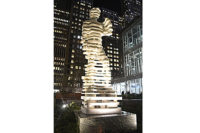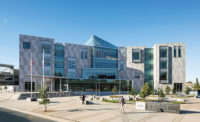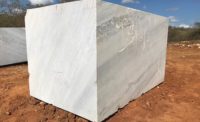
The Wall of Memory and Hope in Albany, NY, was recently completed by installers, Anthony Mion and Son, and architects, Einhorn, Yaffee and Prescott (EYP) Architecture. By using an adhered installation system, the project team was able to reduce costs and labor.
There is a key difference between cost cutting and value engineering. Cutting costs involves a decision as easy as choosing one brand over another to save a few dollars, without necessarily considering the long-term performance and outcome of the project. Value engineering, however, is a totally different discipline. This is a process that takes into account the materials, processes and products, but the end selection is made so as to achieve the desired function of the project at the lowest overall cost consistent with performance.

Anthony Mion and Son installed the stone using Laticrete's Latapoxy 310 Stone Adhesive, a two-component, high-strength construction epoxy adhesive for spot bonding large-format tile and stone on vertical surfaces.
Anthony Mion and Son then considered using Laticrete's Latapoxy 310 Stone Adhesive, a two-component, high-strength construction epoxy adhesive for spot bonding large-format tile and stone on vertical surfaces. The idea was approved by EYP, and the costs were subsequently reduced.

The project is a massive 25- x 18-foot wall designed to hold glass plaques honoring the passing of cancer victims.
Anthony Mion and Son went to work redesigning the wall so that the aesthetics of the original design would not be altered. This was achieved by building a CMU block wall as the main structure, reducing the marble thickness to ¾ inch, and using Laticrete's cordless mixing gun to apply the Latapoxy 310 Stone Adhesive to the veneer of the new main structure. A major benefit of switching to the new plan was reducing the cost of labor necessary to complete the tasks. Latapoxy 310 is the fastest system available to clad vertical substrates, and is building code approved by ICC, BOCA, ICBO and SBCCI. “We were able to significantly cut labor costs, and still get more done per day,†Roman said. “We dropped the thickness of the marble, and were able to complete the job quicker and cheaper without compromising the original design.â€

With the marble pieces tightly adhered to the face of the block, Anthony Mion and Son finished the job off by using Laticrete's 255 MultiMax thinset mortar to wrap the sides of the wall in black granite, creating the final aesthetic.
With the marble pieces tightly adhered to the face of the block, Anthony Mion and Son finished the job off by using Laticrete's 255 MultiMax thinset mortar to wrap the sides of the wall in black granite, creating the final aesthetic. “There is a stainless steel vertical in the center and an LED light that sets up a beautiful dynamic,†said Roman. “It's just an impressive wall in an impressive lobby. The marble looks like its floating off the wall.â€





